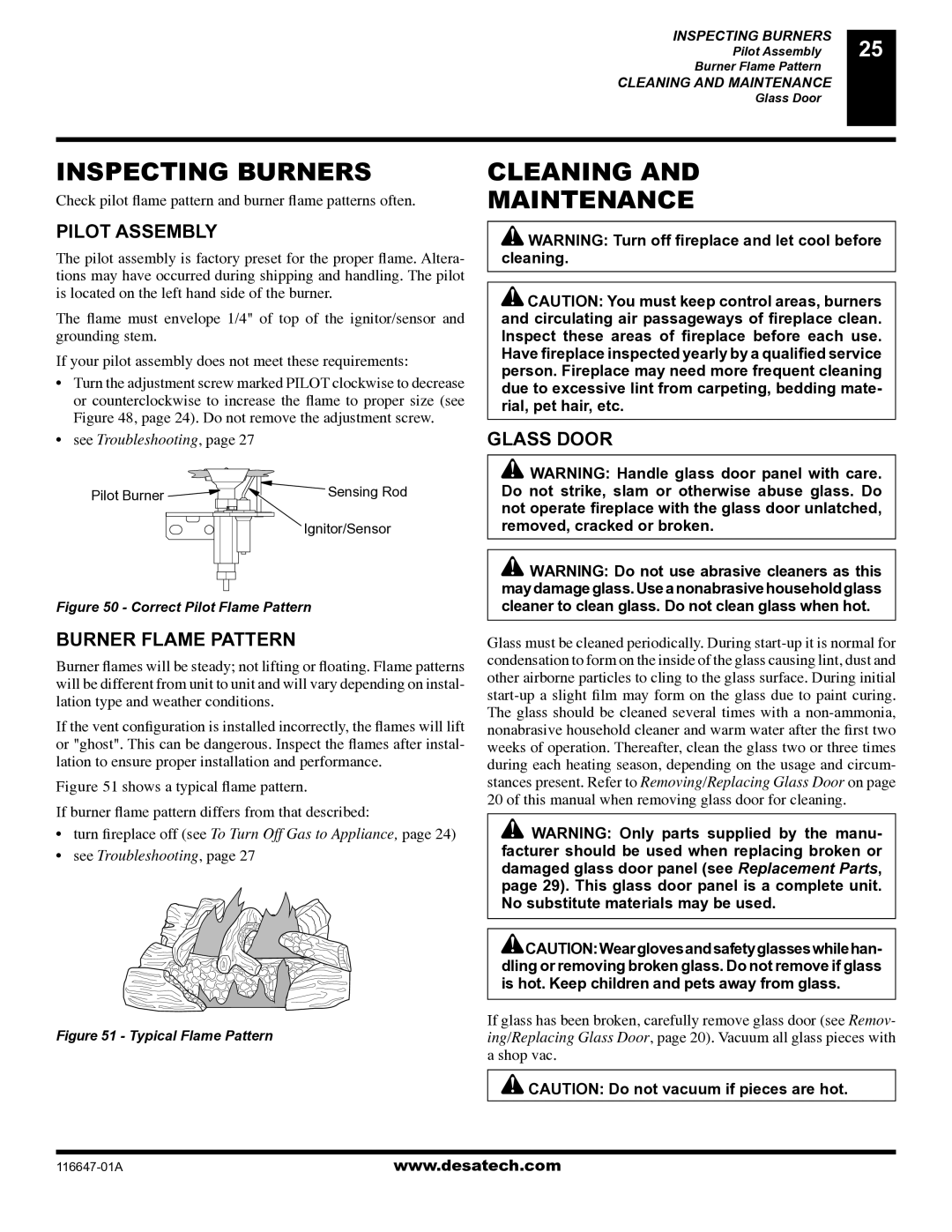
INSPECTING BURNERS
Pilot Assembly
Burner Flame Pattern
CLEANING AND MAINTENANCE
Glass Door
25
INSPECTING BURNERS
Check pilot flame pattern and burner flame patterns often.
PILOT ASSEMBLY
The pilot assembly is factory preset for the proper flame. Altera- tions may have occurred during shipping and handling. The pilot is located on the left hand side of the burner.
The flame must envelope 1/4" of top of the ignitor/sensor and grounding stem.
If your pilot assembly does not meet these requirements:
•Turn the adjustment screw marked PILOT clockwise to decrease or counterclockwise to increase the flame to proper size (see Figure 48, page 24). Do not remove the adjustment screw.
•see Troubleshooting, page 27
Pilot Burner | Sensing Rod |
| |
| Ignitor/Sensor |
CLEANING AND
MAINTENANCE
![]() WARNING: Turn off fireplace and let cool before cleaning.
WARNING: Turn off fireplace and let cool before cleaning.
![]() CAUTION: You must keep control areas, burners and circulating air passageways of fireplace clean. Inspect these areas of fireplace before each use. Have fireplace inspected yearly by a qualified service person. Fireplace may need more frequent cleaning due to excessive lint from carpeting, bedding mate- rial, pet hair, etc.
CAUTION: You must keep control areas, burners and circulating air passageways of fireplace clean. Inspect these areas of fireplace before each use. Have fireplace inspected yearly by a qualified service person. Fireplace may need more frequent cleaning due to excessive lint from carpeting, bedding mate- rial, pet hair, etc.
GLASS DOOR
![]() WARNING: Handle glass door panel with care. Do not strike, slam or otherwise abuse glass. Do not operate fireplace with the glass door unlatched, removed, cracked or broken.
WARNING: Handle glass door panel with care. Do not strike, slam or otherwise abuse glass. Do not operate fireplace with the glass door unlatched, removed, cracked or broken.
Figure 50 - Correct Pilot Flame Pattern
BURNER FLAME PATTERN
Burner flames will be steady; not lifting or floating. Flame patterns will be different from unit to unit and will vary depending on instal- lation type and weather conditions.
If the vent configuration is installed incorrectly, the flames will lift or "ghost". This can be dangerous. Inspect the flames after instal- lation to ensure proper installation and performance.
Figure 51 shows a typical flame pattern.
If burner flame pattern differs from that described:
•turn fireplace off (see To Turn Off Gas to Appliance, page 24)
•see Troubleshooting, page 27
Figure 51 - Typical Flame Pattern
![]() WARNING: Do not use abrasive cleaners as this maydamageglass.Useanonabrasivehouseholdglass cleaner to clean glass. Do not clean glass when hot.
WARNING: Do not use abrasive cleaners as this maydamageglass.Useanonabrasivehouseholdglass cleaner to clean glass. Do not clean glass when hot.
Glass must be cleaned periodically. During
![]() WARNING: Only parts supplied by the manu- facturer should be used when replacing broken or damaged glass door panel (see Replacement Parts, page 29). This glass door panel is a complete unit. No substitute materials may be used.
WARNING: Only parts supplied by the manu- facturer should be used when replacing broken or damaged glass door panel (see Replacement Parts, page 29). This glass door panel is a complete unit. No substitute materials may be used.
![]() CAUTION:Wearglovesandsafetyglasseswhilehan- dling or removing broken glass. Do not remove if glass is hot. Keep children and pets away from glass.
CAUTION:Wearglovesandsafetyglasseswhilehan- dling or removing broken glass. Do not remove if glass is hot. Keep children and pets away from glass.
If glass has been broken, carefully remove glass door (see Remov- ing/Replacing Glass Door, page 20). Vacuum all glass pieces with a shop vac.
![]() CAUTION: Do not vacuum if pieces are hot.
CAUTION: Do not vacuum if pieces are hot.
www.desatech.com |
